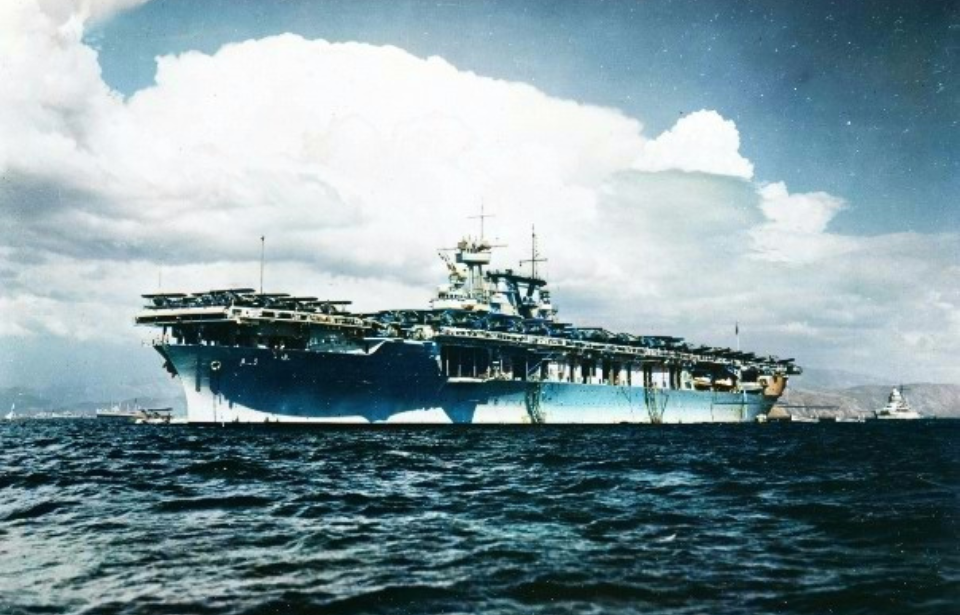After suffering extensive damage in the Battle of the Coral Sea, the USS Yorktown (CV-5) limped her way back to Pearl Harbor as preparations for the imminent attack on Midway were mounting. Over two weeks of work was done in just 48 hours to make the aircraft carrier battle-ready. Yorktown would go on to sacrifice herself to ensure the American victory against the Japanese at Midway.
The USS Yorktown (CV-5) was destined to play a big role
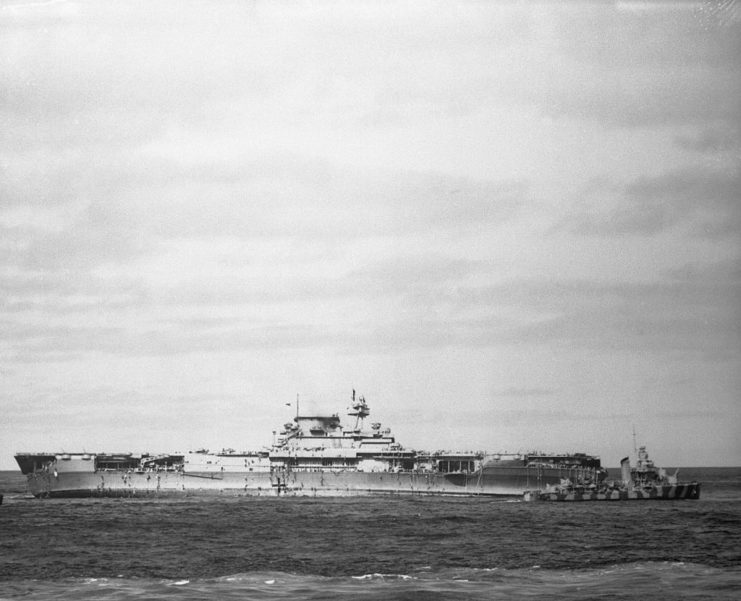
The USS Yorktown was commissioned on September 30, 1937 at Naval Station Norfolk, Virginia, under the command of Capt. Ernest D. McWhorter.
After training throughout the Virgin Islands, Haiti, Guantanamo Bay and Cristobal, the vessel returned to Norfolk in 1938. The following year, she and her sister ship, the USS Enterprise (CV-6), participated in training centered around protecting American interests in the Pacific, something they would soon receive real-world experience in.
The exercises, which included convoy escort, anti-submarine defense and other attack measures, made it clear that, if America became embroiled in war, aircraft carriers would play a significant role in the outcome. They also revealed a lack of coordination between the US Army and Navy’s defense plans surrounding the Hawaiian Islands, especially with the growing threat of German U-boats.
Between the start of World War II and the attack on Pearl Harbor, Yorktown conducted several patrols in the Atlantic to enforce America’s neutrality.
The start of America’s war on Japan
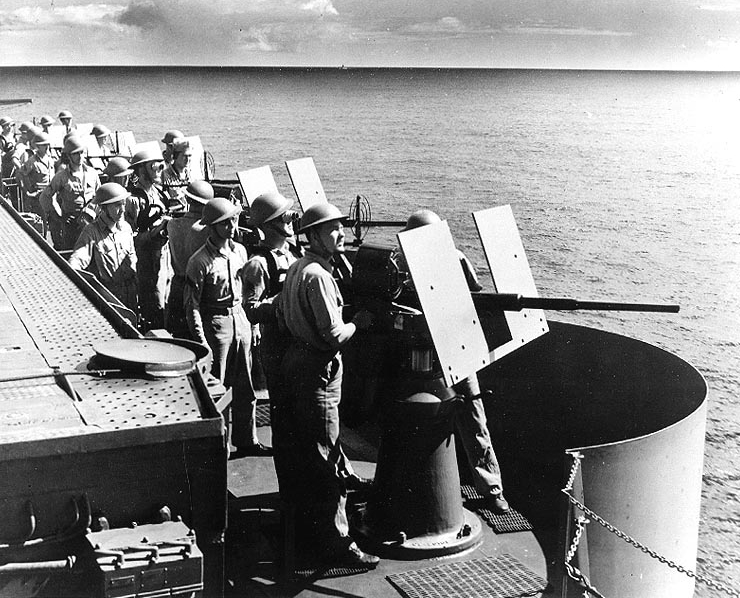
After the brutal Japanese attack on Pearl Harbor on December 7, 1941, the Pacific Fleet was left in dire need of support. Only three carriers remained in the Pacific: the USS Lexington (CV-2), Saratoga (CV-3) and Enterprise, so the USS Yorktown quickly headed toward San Diego, before taking reinforcements to American Samoa in her first official mission in the Pacific Theater.
On February 14, 1942, Yorktown was underway to the Coral Sea to attack Japanese shipping efforts and cover the landing of Allied troops in New Caledonia. News that the enemy was headed toward Australia prompted a swift change of plans. Task force commander Rear Adm. Wilson Brown changed the objective to the Salamaua-Lae area of New Guinea.
On March 10, 104 aircraft were launched from Yorktown and Lexington, and only one was lost, even though the majority of pilots were experiencing combat for the first time. After the successful interception at Salamua-Lae, the aircraft carrier returned to her regular patrols in the Coral Sea, until she was called to intervene in another Japanese operation to build a seaplane base on Tulagi, in the Solomon Islands.
In the engagement, Yorktown delivered 22 torpedos and 76 bombs, sinking the Japanese destroyer Kikuzuki (1926) on the eve of the Battle of the Coral Sea, an offensive that could have determined the course of the war in the South Pacific.
USS Yorktown (CV-5) and the Battle of the Coral Sea
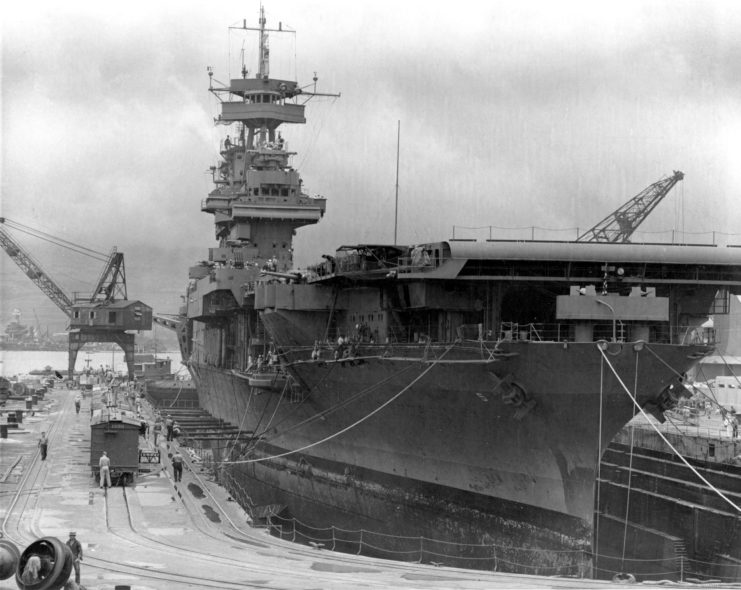
While the Battle of Midway often overshadows this pivotal engagement, the Battle of the Coral Sea helped seal the fate of the USS Yorktown and the outcome of Midway. Both she and Lexington served an essential role. Their aircraft located the Japanese vessel Shōhō and promptly sunk the enemy aircraft carrier. The following day, May 8, Lexington located the carriers Zuikaku and Shōkaku.
Yorktown‘s aircraft damaged Shōkaku‘s flight deck, grounding her bombers. However, the Japanese soon turned the tide of the battle. Lexington took two torpedos to the port side and three bombs from overhead, while Yorktown lost 66 men to an explosion after a bomb hit her flight deck.
When all was said and done, the Japanese won a tactical victory and Yorktown suffered severe damage. The overhaul was estimated to take three months, but there was next to no time for repairs. Intelligence had decoded messages and revealed the Japanese were heading toward Midway.
Adm. Chester W. Nimitz began planning one of the most famous battles of the Pacific, and his plan included the wounded Yorktown, which was being worked on around the clock to prepare for what would be the battle of her life.
The USS Yorktown‘s (CV-5) sacrifice at the Battle of Midway
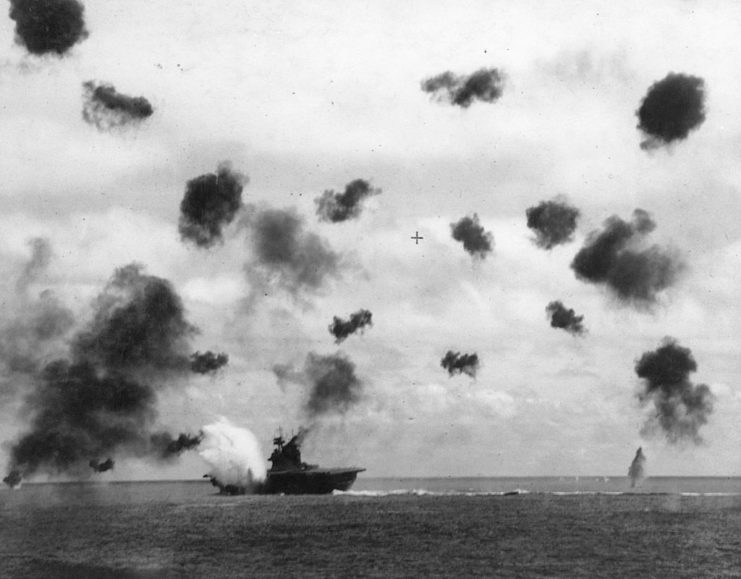
On May 30, 1942, the USS Yorktown set sail for Midway as the central ship of Task Force 17 (TF 17). A few days later, on the morning of June 4, 10 Douglas SBD Dauntless took off from Yorktown to patrol the area, but came back after several hours without any enemy sightings. Meanwhile, the USS Enterprise and Hornet (CV-8) launched their own attack groups. Torpedo aircraft located the Japanese forces, but of the 41 launched, only six returned.
In bringing down the American aircraft, the Japanese ones had come down from their high-altitude hideouts to attack low-flying Douglas TBD Devastators, leaving the sky above them available for the Dauntless dive bombers to make their move. Yorktown‘s bombers attacked Sōryū, leaving her aflame and quickly taking on water. Enterprise‘s bombers struck Akagi and Kaga with similar force, leaving the Japanese ships in ruin.
With three carriers gone, the only remaining ship, Hiryū, was nowhere to be found. Soon, a team of Aichi D3A Typ 99 carrier bombers descended upon Yorktown. As the Japanese aircraft approached, the vessel launched her fighters to intercept. Both sides fought in a relentless dogfight as dozens of aircraft dove in and out, bursting into flames before falling to the ocean below.
The Japanese attack aircraft scored three vital hits on Yorktown, and as she continued to fight back, two torpedos tore into her port side, sealing her fate; she would soon find herself in the watery depths. Yorktown fell dead in the water and began to list as the order to abandon ship sounded out. Above the sinking carrier, her fighters were still bombarding Hiryū.
Both Hiryū and Yorktown were fatally hit and left to drift. Even as the Americans were struggling to save the aircraft carrier, the Japanese submarine I-158 landed two torpedo hits on her. On June 7, 1942, Yorktown turned over on her port side and sank 18,000 feet below the surface, claiming the lives of 141 officers and crewmen.
An enduring legacy
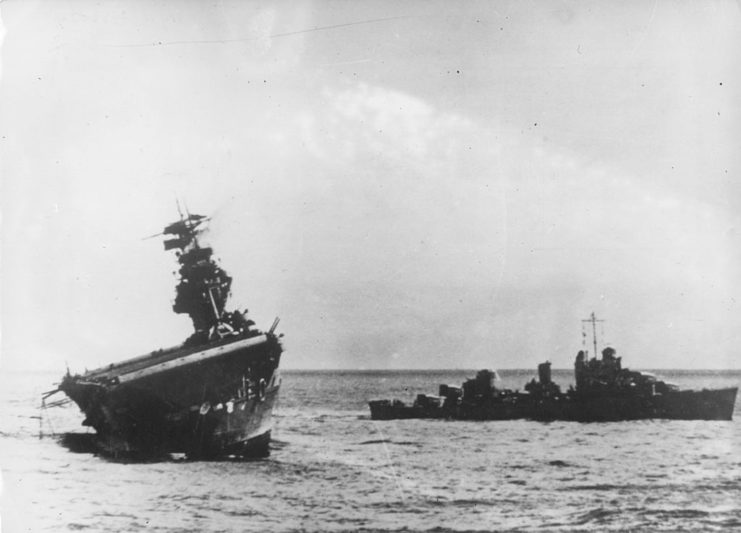
Despite suffering extensive damage in the weeks leading up to Midway, the USS Yorktown served valiantly right to the very end. She was awarded three battle stars for her significant contributions in stopping the Japanese expansion in the Pacific during the battles of the Coral Sea and Midway.
The aircraft carrier’s legacy continues today. The second vessel to bare her name, the USS Yorktown (CV-10), was renamed in her honor, having started out life as the Bon Homme Richard. She was preserved following her decommissioning in 1970, becoming a museum ship.
More from us: The USS Laffey (DD-724) Was Known As ‘The Ship That Would Not Die’
The original Yorktown‘s sacrifice helped the US win a crucial victory over the Imperial Japanese, a testament to her strength and the valor of all those who served aboard the aircraft carrier.
